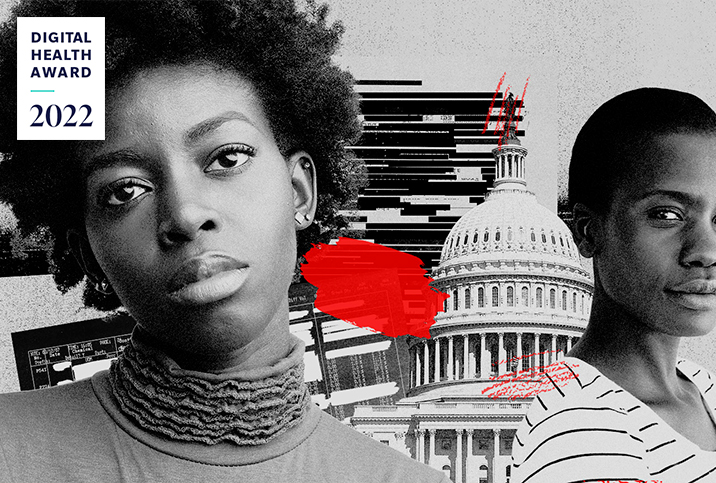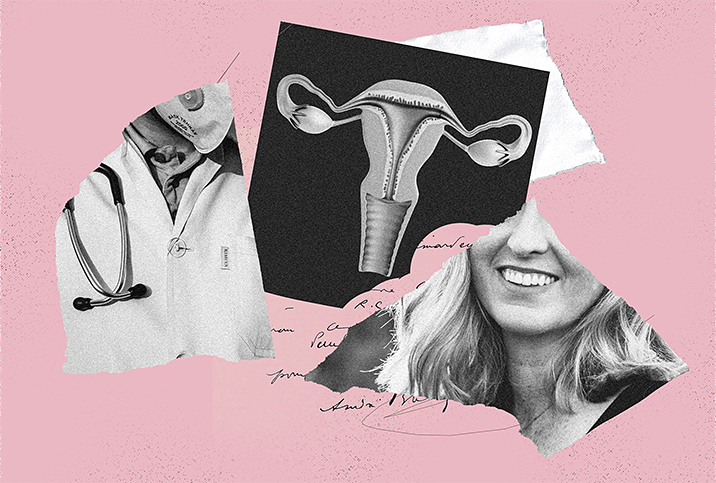Why So Many Hysterectomies for Black Women?

In 1961, civil rights activist and leader Fannie Lou Hamer checked in to a hospital in Sunflower County, Mississippi, to have a small, benign tumor removed. She walked in expecting a minor procedure but left sterilized—her entire uterus was removed without her knowledge or consent.
Hamer was the victim of a widespread form of anti-Black sterilization, known as a "Mississippi appendectomy," that plagued the United States in the mid- to late 20th century. According to Hamer's account, 6 out of every 10 women in Sunflower County in the '60s were subjected to non consensual sterilization.
Black women are at least twice as likely to have their uterus removed compared to white women.
This practice set the stage for decades of forced sterilization of Black, Indigenous and Latina women. As recently as 2020, Project South reports suggest the practice continues on women of color.
Today, Black women are at least twice as likely to have their uterus removed compared to white women. This is often done to treat uterine fibroids, which impact Black women significantly more than women of other races.
However, even when accounting for all women with fibroids, Black women are still more likely to be treated with hysterectomy. While no singular reason for this trend has been identified, limited access to structurally competent health care and the remnants of systemic racism are likely contributors.
Hysterectomies and the historical perspective
To understand how racism has played a role in the disparities we see today, we must look to the work of scholars, such as Dorothy Roberts and Harriet A. Washington, to understand the historical systemic dehumanization and forced sterilization of Black women.
Starting in the early 20th century in the United States, there was an emergence of eugenics laws that supported the idea of cleansing society of undesirable groups, which included people with disabilities, people of color, people with mental illness, and people who were incarcerated.
These ideals were championed across 32 states with sterilization laws supported by the Supreme Court in the 1927 Buck v. Bell case, a ruling that enforced the sterilization of Carrie Buck, a white woman who had been committed to a mental health institution for being "feebleminded." This case justified the sterilization of women of color, especially those institutionalized in mental health and carceral facilities.
For 70 years, California was the leading state of sterilization procedures in the United States. State-run public institutions performed 20,000 procedures—often without consent—making up more than 30 percent of the total number performed nationally. These heinous acts went on to inspire Adolf Hitler and helped create the blueprint for sterilization in Nazi Germany.
Despite efforts for reparations for victims, the problem persists today. Nearly 26 percent of California's incarcerated adult female population are Black, despite making up only 5.7 percent of the state's adult female residents.
In 2020, filmmaker Erika Cohn released the documentary "Belly of the Beast," which highlights the continued oppression of Black incarcerated women through forced sterilization in California's prisons.
The historical and ongoing instances of forced sterilization of Black women undergird a sentiment of society's disregard of Black women and their right to their bodies. It also represents the medical and public health institution's explicit devaluation of those bodies. From unconsented Depo-Provera trials in Atlanta to lingering questions regarding historical contraception campaigns, the distrust of these institutions is justified and an act of self-preservation.
Today, Black women continue to receive hysterectomies at a disproportionate rate compared to white women, despite other options available to them. While historical context plays an important role in why we might see this trend, we must first understand and examine the process behind deciding to get a hysterectomy in the first place.

Hysterectomy disparities characterized
About 86 percent of hysterectomies are for noncancerous or benign indications: fibroids, adenomyosis, endometriosis, uterine prolapse or abnormal uterine bleeding. The remainder are performed to diagnose and treat pelvic cancers.
Most women who have hysterectomies for noncancerous reasons do so because of fibroids. These can cause significant pain, heavy or frequent bleeding, and bowel or bladder compression.
Overall, Black women are three times more likely than white women to have fibroids—the reasons for which are multifaceted. However, even among women with fibroids, Black women are four times as likely as white women to undergo invasive treatments like a hysterectomy.
While some fibroids can be treated without surgery, a hysterectomy is considered a "definitive" treatment because it treats the source of the problem rather than the symptoms. No surgery is without risk, but Black women are less likely to receive minimally invasive hysterectomies (less extensive surgeries with a lower risk of complications than traditional "open" procedures) and more likely to have complications. Why are Black women so much more likely to undergo surgery for this problem?

Access to care and medical knowledge among Black women might offer one answer. Difficulties in accessing medical care or hysterectomy alternatives due to spatial and other structural barriers may delay receipt of care until one's disease process becomes too severe for alternative management options. Despite Black women's increased use of minimally invasive hysterectomies in recent years, the "catch up" to rates among white women may demonstrate that Black women often have difficulty accessing safer avenues of care.
Discrimination and interpersonal racism may also play a role in the disparities we see. In a survey of more than 300 African American women, of those who saw a healthcare provider for family planning or birth control services, 67 percent reported experiencing race-based discrimination. Examples included receiving poorer-quality services and encountering stereotypes of African American women, including the assumption of multiple sexual partners. Stronger Black identity, younger age and lower income were associated with reports of discrimination.
A different study reported experiences of seeking both general andpregnancy-related care among black patients who were at risk for preterm birth. Of the 54 participants, 22 identified as Black and three as mixed-race. Almost all participants described experiences of disrespect and dismissal of their wishes. Many felt ignored or that they received lower-caliber care, with one participant witnessing a change in a physician's demeanor when interacting with her: "They cut costs, cut edges or [withhold information]."
The women in the study also described "stressful interactions" during healthcare encounters due to their medical problems—worsened by uncoordinated care services and a lack of empathy from staff regarding the challenges of securing frequent medical care. All expressed "unmet information needs" with respect to diagnostic and treatment-related education offered by clinical staff.
Another study interviewed 37 Black women seeking fibroid treatment. Their management decisions were affected by themes including "patient-provider interactions," in which symptoms were sometimes wrongly attributed to other problems. They were also impacted by "the social and historical value of the uterus" (the ways in which women are devalued simply because they are women), with one participant wondering if the dearth of information she and others received was related to clinicians perceiving them as less valuable.
Studies foregrounding Black women's voices across a range of reproductive care settings, including fibroid treatment, highlight the continued legacy of discrimination toward Black women within healthcare settings. In particular, Black women reporting discrimination were less likely to use contraceptives—arguably the most popular option for nonsurgical treatment of fibroids.
This research suggests that experiences with discrimination decrease Black women's usage of nonsurgical treatment options, or damage patient-clinician relationships, and may contribute to the disparities we observe.
Reproductive justice and potential solutions
The disparities we see are the result of systemic inequities with centuries-old origins, and a resolution requires a multifaceted approach that centers the voices of Black women.
One way to counter these challenges is to prioritize community-based solutions rooted in reproductive justice. This term, first coined in 1994 by a group of 12 Black women, combines the ideals of reproductive rights and social justice. At the core of reproductive justice is the idea of intersectionality—the recognition of intersecting systems of oppression.
Whether it results in limited access to health care or job opportunities, the intersection of these systems makes it more challenging for Black women to achieve optimal health for themselves, their communities and their children. Therefore, legislation, such as the MOMMIES Act, provides a framework for how policy can be used to address these challenges, but will similarly require centering community voices to ensure it is effective.
To promote reproductive justice, medical, governmental and public health institutions first need to acknowledge the historical and ongoing forms of systemic racism that have impacted Black women. These systems must also do the work to acknowledge how this racism continues in their everyday work and practices.
Data continues to reflect that, when corrected for education and income, Black women still experience higher rates of hysterectomies compared to their white counterparts. Several instances also demonstrate that stereotypes and perceptions of Black women have a direct impact on the quality of care they receive. One idea to address this is through anti-racism training led by Black women who specialize in this area. Some examples are Health Justice, Just Equity for Health and The Equitist.
In addition to doing internal work to recognize these challenges, organizations must also prioritize the improvement of access to full-spectrum quality gynecological care. This can be promoted through increased partnerships between community clinics and hospitals that offer minimally invasive procedures. Training and subsidies can also be provided for academic institutions serving Black women so this resource is readily available within their own communities.
Lastly, increased access to information and education about reproductive health is essential. Organizations such as HERS Foundation, The White Dress Project and National Birth Equity Collaborative are already doing that work. They provide information about hysterectomies and uterine conditions to promote informed decision-making and empower communities about their health.
While we have come a long way from the unfortunate events in Sunflower County, Mississippi, we believe Fannie Lou Hamer would have encouraged us to continue to fight for the ideals of reproductive justice in every sense of the term. Although we have made progress, these disparities will continue to exist as long as systemic and interpersonal racism is not addressed intentionally through critical self-reflection and action. It's up to our institutions to take up this mantle, but until then we'll be here to do the work of protecting the communities we care about.
We would like to acknowledge the limited scope of this report as it is primarily focused on binary female populations and is a reflection of the current data available to us. However, we recognize the intersectionality of reproductive justice, especially as it relates to our queer, nonbinary and intersex community members. More inclusive advocacy and work is necessary to understand the unique ways minoritized sexual and gender populations are harmed by sterilization and systemic forms of oppression that impact their health. To learn more about ongoing advocacy in this space, please check out the policy summary by the Open Society Foundations.
Naomi F. Fields is a medical student at the University of Pennsylvania and currently applying to begin OB-GYN residency training during the summer of 2022.
Efosa Enoma recently received her bachelor of science degree at Northeastern University and is a research technician in the Bernstein lab at Dana-Farber Cancer Institute, a principal teaching affiliate of Harvard Medical School.
LaShyra Nolen is a writer, student at Harvard Medical School, and the founding executive director of the We Got Us Empowerment Project.



















Commentary